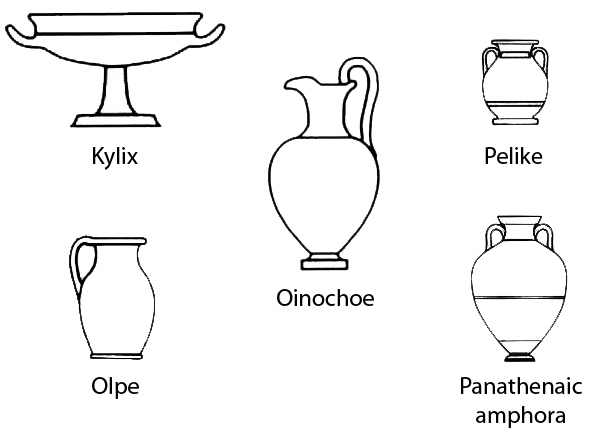
There is a long history in the typology of ancient Greek vases. Typological studies group ceramics according to their physical characteristics, such as material and shape. Each group is then assigned to a specific time period, which is often used to date archaeological contexts and vice versa. Attribution studies have gone a step further by identifying the hands of potters, artists, and production centers. In this process, Greek pottery shapes are largely identified with names well known in the ancient written sources.
Athenaeus, a grammarian living in the end of the second and the beginning of the third century CE, wrote an extensive work on banqueting customs in a dialogue form. Book XI introduces the discussion on drinking-cups (ἐκπώματα). Quoting many works and authors, he relates descriptions of various vases. He also reports the open debates on names, such as the existence of two different names designating the same vase. For example ἄλεισον and δέπας are both used to describe a goblet resembling a φιάλη (XI 783a); κύπελλον is again the same (XI 482e). Various authors discuss other names and shapes: for example, θηρίκλειος – a type of κύλιξ. Some say that θηρίκλειος is similar to a καρχήσιον or to a κρατήρ (mixing-bowl, XI 470e-472e), but again there is debate as to which name should describe which shape.
Perhaps the most confusing description as to the correspondence between names, shapes, and functions, in Athenaeus’ discussion is that relating to the πελίκαι:
Callistratus in the Commentary on Cratinus’ Thracian Women, defines this [the πελίκη] as a κύλιξ. But Crates in book II of the Attic Dialect writes as follows: pitchers (χόες) were referred to, as I noted, as πελίκαι. The shape of the vessel was previously like that of a παναθηναικόν (at which time it was referred to as a πελίκη), but later it took on the look of an οἰνοχόη (wine-pitcher), like those set beside people at the festival (οἷοί εἰσιν οἱ ἐν τῇ ἑορτῇ παρατιθέμενοι). These were the type they referred to in those days as ὄλπαι, and which were used to pour wine, as Ion of Chios says in The Sons of Eurytos: “Draw potent wine from sacred jars and pour it gurgling forth from olpai.” Whereas nowadays the use of vessels of this type is restricted, as it were, and they are only set beside us at the festival, while the shape of the type that has come into common use (and which we refer to as a χόα) has evolved, and is more like an ἀρύταινα (dipper).[1]
Callistratus is a grammarian who lived in the second century BCE, i.e. almost three to four centuries before Athenaeus, while Crates and Ion lived in the fifth century BCE. Modern scholars often describe the shape of the pelike as a “container of liquids.” In Callistratus’ time, according to Athenaeus, a pelike resembled a κύλιξ that is a broad and shallow drinking cup. The authors of the fifth century BCE, however, give yet another description. The pelike, for them, was associated with a pouring jug or pitcher, the choes. The latter shape is explicitly associated with the Choes – the name of the second day of the Anthesteria festival. Further comparisons of the choai with other shapes appear with the panathenaic amphorai that were once called pelikai. What we call nowadays an amphora or a pelike, however, are not pouring shapes.
Even though we may attribute ancient names to ancient pots, there was clearly confusion about these attributions already in antiquity. The association of shapes, functions and names is not a stable one and changes over time. Grammarians would analyze names and uses according to what they could see in their time and the sources they had at their disposal. Modern scholars, however, have introduced a different type of confusion in their typologies while trying to establish a one-to-one correspondence between vases and ancient names without often taking into account these chronological discrepancies and ancient debates. Names do not exactly correspond with function and the latter does not exactly correspond with shapes. Looking for specific uses, our modern categories would be enhanced if we described ancient artifactual categories from a less charged and a more neutral perspective, instead of applying ancient Greek names onto them – especially when the latter were already debated in antiquity.
[1] Athenaeus XI, 495a-c. Translation Olson.
